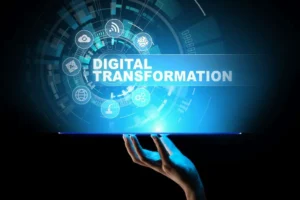Digital Twin Technology: What Is It and How Does It Work

Creating a digital twin no longer sounds like a story from a fantasy book. In the realm of Industry 4.0, with the help of real-time data, creating a virtual analog of any object is within the realm of attainability. The practice grows like wildfire yearly due to DTA (Digital Twin Applications) in testing ideas, products, and technologies in real scenarios. McKinsey notes that 70% of corporate IT managers prefer these technologies and are actively getting to grips with them. In the article, we’ll touch on digital twin technology, show examples of its current business applications, and suggest some tips for using it in your venture.
What Is Digital Twin Technology?
A digital twin refers to an electronic replica of an actual thing constructed of input from IoT sensors on actual equipment. With real-time info from asset sensors, a duplicate may emulate actions and behavior. With the help of this invention, imitating a great scope of genuine items, from little components of manufacturing machinery to enormous structures, is a viable option. Furthermore, the tech is expanding so quickly that it may build entire cities.
The metaverse is also taking advantage of the new technology. Here, digital doubles take up the role of the instruments that users may make and utilize in the metaverse to represent themselves in the virtual world. It might involve identification, communication, and operating its digital copy to engage in various virtual settings. Thus, digital twins might become one of the metaverse’s instruments for virtual reality engagement and interaction.
Creating a twin is a breeze. You may just scan and model the real-world thing. Experts employ a variety of sensors for this, comprising pressure, temperature, laser scanners, and webcams. As an illustration, to make a duplicate of a sports automobile, you need up to 300 sensors.
After that, the digital twin software scans the item utilizing the data to build a meticulous 3D model. AI tech helps to replicate the original’s bodily motions and reactions without delay.

Let’s now examine the primary use cases of the technology:
- Logistics. Supply chain enterprises successfully employ digital twins. The extensive adoption of IoT tools in logistics also helps with it. Practically every item in a warehouse may be digitalized. Doubles may help you efficiently arrange the warehouse and the shipping and unloading procedures.
- Retail. Digital twin technologies have a direct impact on employee labor as well as logistics in the retail sector. One may employ a digital model to prepare the best layout of a store’s interior, merchandise display, shopping lane layout, and merchandising.
- Medicine. One of the most potential use cases for digital twins is medicine, which currently uses sophisticated virtual simulations of human organs for treatment and diagnosis. It’s conceivable that as medical data volumes rise, physicians can build “medical doubles” of their patients by using complex bodily data. It creates fantastic opportunities for therapy, or it even allows for the prediction of the disease before symptoms manifest.
- Managing Product Lifecycle. PLM is intricate and time-consuming, yet incorporating digital twins simplifies and enhances it. They provide invaluable insights and analysis by retaining easily accessible historical data. They prove essential for detecting faults and diagnosing issues. Moreover, they enable simulations that predict real-world performance under various scenarios.
- Digital twins help power plants run more efficiently, prevent blackouts in the electrical supply, and handle energy use more sensibly. GE’s customers have benefited from more than $1.5 billion in savings because of digital twins.
- You may model a network as a whole as well as a single device or service, considering security against online attacks and computing maximum loads.
Digital twins surpass conventional models by dynamically merging the physical and digital worlds and utilizing cutting-edge technology like AI, machine learning, and intelligent sensors to specify and prevent system problems. This capacity provides informational input to the original physical element through projected outcomes. Additionally, they provide immediate insights and suggestions to refine operations, reduce expenses, and enhance productivity using advanced analytics and ML algorithms.

We are confident that we have what it takes to help you get your platform from the idea throughout design and development phases, all the way to successful deployment in a production environment!
Why Is Digital Twin Technology Important?
This solution is one of Industry 4.0’s fastest-growing concepts. The market for digital twins is significantly impacted by the expansion of cloud computing and the Internet of Things (IoT) sectors. There are several explanations why you should pay attention to this tech:
- Productivity may be raised. You may get real-time analytics and data using digital twins. It enables you to get the most out of your facilities, machinery, and factory. Resolving issues when they arise reduces downtime and maintains optimal system performance.
- These technologies may provide you with a comprehensive digital and visual picture of your office building, industrial factory, or other location, even with hundreds of pieces of equipment. Smart sensors track the output of every component and identify issues or faults. Instead of holding off until the machinery breaks down entirely, you might step in as there are signs of concern.
- Businesses can study internal statistics and identify system breakdowns beforehand, since the digital twin system’s IoT sensors create huge amounts of data without delay. It makes it possible to switch to predictive maintenance, which lowers operating costs and facilitates production line efficiency.
- Predictive maintenance is one significant use. They can schedule repairs, anticipate maintenance requirements, and avert expensive downtime by resolving problems before they worsen by tracking physical asset data.
- Virtual twins offer a visual depiction of tangible assets or systems. It offers a thorough comprehension of their relationships, output, and standing.
Additionally, you may prevent financial costs from decreased production by using digital duplicates. As an illustration, company owners used to have to halt all operations to test the latest warehouse modules. These days, everything takes place digitally, and it’s simple to double-check how effective the settings are.
Actual Examples of Digital Twin Technology
By 2026, we anticipate an influx of investments in digital twins that will reach 48 billion dollars. These solutions will be paramount to the design of products, production, upkeep, and repair. Virtual prototypes of items and industrial operations are produced using these technologies. World-renowned companies are already taking the best out of the potential of this technology. Let’s touch on the digital twin examples:
- BMW makes an exact virtual replica of genuine automobiles with the aid of technology. It boosts planning and logistics management and enables testing and improvement before production.
- Anglo American, a coal business, optimizes mine operations and lowers worker dangers with virtual twins to generate precise mining equipment and structure models.
- Using this tech, Lockheed Martin develops virtual prototypes of different aircraft and spacecraft.
- An online retailer, Alibaba employs digital replicas to make perfect doubles of its logistics infrastructure and warehouses. It helps the company streamline operations and manage inventories better.
- For each vehicle it sells, Tesla builds a digital duplicate. Its sensors provide data to the manufacturer, where artificial intelligence determines if the equipment needs repair or is running normally. Additionally, the business remotely repairs specific issues by only upgrading the car’s software.
- Chevron Corporation uses tech to anticipate technical issues in refineries and oil fields.
- Singapore has a dynamic three-dimensional city model, complete with buildings, bridges, curbs, and trees. State agencies provide information to Virtual Singapore, and city sensors offer data. Twin technology benefits include the chance for the government to anticipate emergency response times and for architects to plan new projects with the city’s infrastructure in mind.
You can leverage the capabilities of the Global Cloud Team to harness the technology. Accessing a flexible and scalable enterprise-grade DTP (Digital Twin Platform) for hosting your digital counterpart is easy. The experts offer consultations, programming, and systematic modeling to bring your virtual twin vision to life.

Tips for Using Digital Twin Technology
It’s best to enforce technology using specialized tools or procedures and expand it if the pilot project succeeds. It’s the typical workflow of the incorporation process:
- Before enforcing the first digital replica, consider which departments and equipment need it the most. Since the copy makes it viable to address some production challenges, it’s ideal for the chosen equipment to be a crucial part of the manufacturing procedure.
- Select the equipment or procedure of your pilot project by reducing the number of options available. Postpone digitizing extremely complicated machinery or processes as it leads to issues during the pilot phase.
- The creation and execution of a pilot project is the next stage. Future scalability and complete solutions are demanded if you want a digital twin of a factory or other organization that doesn’t rely on outside contractors.
- The digital twin technology is scalable, indicating the success of the pilot project. Establishing virtual replicas of procedures near or related to the pilot could be beneficial. It’s crucial to consider the difficulties you had when writing your first replica model and the problems you want to solve.
- Following DTI (Digital Twin Implementation), monitoring tools will help you determine the prospects a digital twin offers your venture. To choose the best configuration, you might iteratively modify the virtual copy.
Local servers and private or public clouds can host the technology. Should an object’s simulation model operate on the business’s servers, hardware purchases, and ongoing upkeep by a team of technical experts are required to support the infrastructure.
It will need data science and cybersecurity experts and programmers, testers, and designers to develop digital production twins. Nowadays, very few businesses are prepared to handle the challenges of such expansion without the help of seasoned partners or outside contractors. Therefore, you might seek assistance from Global Cloud Team, a software engineering company that offers sophisticated technical solutions, if you want the most significant outcome on your path to digital transformation.
Wrapping Up
Even though numerous sectors currently employ virtual twins, they have shown only a part of their potential. Expanding the big data and machine learning usage will aid in defining the system’s actual capacities. Simulation models are metamorphosing into an influential digitalization technology in several fields.
The primary benefits of digital twin technology are the capacity to test a product or production version without making large expenditures and the ability to anticipate the product’s performance in the long run. Moreover, with this tech, you can discover weak points at the launch stage, preventing difficulties in subsequent operations. In other words, by utilizing a data center’s power, you outperform rivals and reduce financial risk while maximizing corporate efficiency.
Global Cloud Team is the better option to learn more about innovations. Our team allows the clients to quickly add R&D resources on demand by utilizing the onshore, offshore, and offshore infrastructure. It permits deliberate software and product development scaling, saving as much as 40% on R&D expenses. Select the Global Cloud Team, and we’ll demonstrate the promising future of your business.
Top Articles
What is Hyperautomation: A Comprehensive Overview of Key Components
I am here to help you!
Explore the possibility to hire a dedicated R&D team that helps your company to scale product development.






